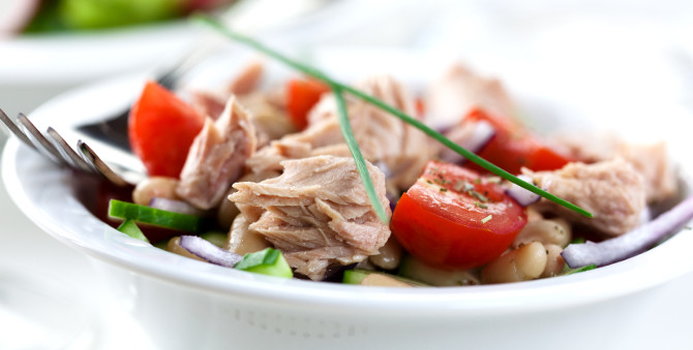Tuna salad is packed with nutrients, and can be fairly low in calories depending on how you prepare it. The two main ingredients in tuna salad are generally canned tuna and mayonnaise -- however, you can substitute other ingredients for regular mayonnaise. The way you prepare tuna salad determines how nutritious it is.
Nutrients in Tuna
Tuna is a high-protein food and rich in omega-3 fatty acids -- including docosahexaenoic acid (DHA) and eicosapentaenoic (EPA). A 3-ounce portion of canned light tuna contains just 73 calories, but provides almost 17 grams of dietary protein. Tuna is also a good source of iron, niacin, vitamin B-12, and iodine. A 3-ounce portion of canned light tuna generally contains about 210 milligrams of sodium. So if you're trying to reduce the sodium in your diet, try low-sodium varieties of canned light tuna instead.
Tuna with Mayonnaise
Because regular mayonnaise is a fat, it's high in calories -- containing about 95 calories in just 1 tablespoon. Therefore, the more regular mayonnaise you add to your tuna salad the higher in calories it will be. The good news is that the majority of fat found in mayonnaise is from heart-healthy mono- and polyunsaturated fats -- including omega-3 fatty acid alpha-linolenic acid (ALA). Common ingredients in mayonnaise include soybean oil, eggs, salt, vinegar, and lemon juice. Some brands also contain olive or safflower oils as ingredients. Mayonnaise is a source of vitamin K, but does contain about 90 milligrams of sodium per tablespoon.
Mayonnaise Substitutions
Using light mayonnaise instead of regular mayonnaise in your tuna salad significantly cuts calories, and choosing mayonnaise substitutes helps reduce sodium. For example, 1 tablespoon of light mayonnaise contains just 36 calories -- but generally 125 milligrams of sodium. To help reduce the sodium content of your tuna salad, try using plain soy yogurt, plain nonfat yogurt, or silken tofu instead.
Adding Fiber
Because tuna and mayonnaise -- the two main ingredients in tuna salad -- don't provide fiber, adding fruits, nuts, or cut-up vegetables to your recipe will give it that extra boost of fiber. For example, add dried cranberries, walnuts, pecans, sliced almonds, or chopped-up grapes, apples, celery, carrots, radishes, or cucumbers to add fiber to tuna salad.
Mercury Considerations
While tuna -- and tuna salad when prepared in a healthy way -- is packed with nutrients and heart-healthy, certain population groups should limit tuna intake because it's a source of mercury. Mercury is toxic when consumed in large amounts. For this reason, pregnant and nursing women and young children should limit low-mercury fish -- including canned light tuna, salmon, Pollock, catfish, cod, tilapia, and shrimp -- consumption to 8 to 12 ounces per week, suggests the U.S. Food and Drug Administration. These population groups should avoid high-mercury fish.

An experienced health, nutrition and fitness writer, Erin Coleman is a registered and licensed dietitian and holds a dietetics degree from the University of Wisconsin-Madison. She also has worked as a clinical dietitian and health educator in outpatient settings. Erin's work is published on popular health websites, such as TheNest.com and JillianMichaels.com.



